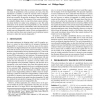Free Online Productivity Tools
i2Speak
i2Symbol
i2OCR
iTex2Img
iWeb2Print
iWeb2Shot
i2Type
iPdf2Split
iPdf2Merge
i2Bopomofo
i2Arabic
i2Style
i2Image
i2PDF
iLatex2Rtf
Sci2ools
ECAI
2008
Springer
2008
Springer
A probabilistic analysis of diagnosability in discrete event systems
Abstract. This paper shows that we can take advantage of information about the probabilities of the occurrences of events, when this information is available, to refine the classical results of diagnosability: instead of giving a binary answer, the approach we propose allows one to quantify, in particular, the degree of non-diagnosability in case of negative answer. The dynamics of the system is modelled by a reducible Markov chain. A state of this chain contains information about whether it is faulty (resp. ambiguous) or not. The useful refinements of the decision about diagnosability are then obtained from the asymptotic analysis of this Markov chain. This analysis may be very useful in practice since it may lead to take the decision of tolerating some non-diagnosable systems, if their non-diagnosability is not critical, and thus allows one saving the cost of additional sensors necessary to make these systems diagnosable. 2 . 1 MOTIVATION One major requirement in designing today'...
Artificial Intelligence | Chain Contains Information | ECAI 2008 | Markov Chain | Reducible Markov Chain |
| Added | 19 Oct 2010 |
| Updated | 19 Oct 2010 |
| Type | Conference |
| Year | 2008 |
| Where | ECAI |
| Authors | Farid Nouioua, Philippe Dague |
Comments (0)

